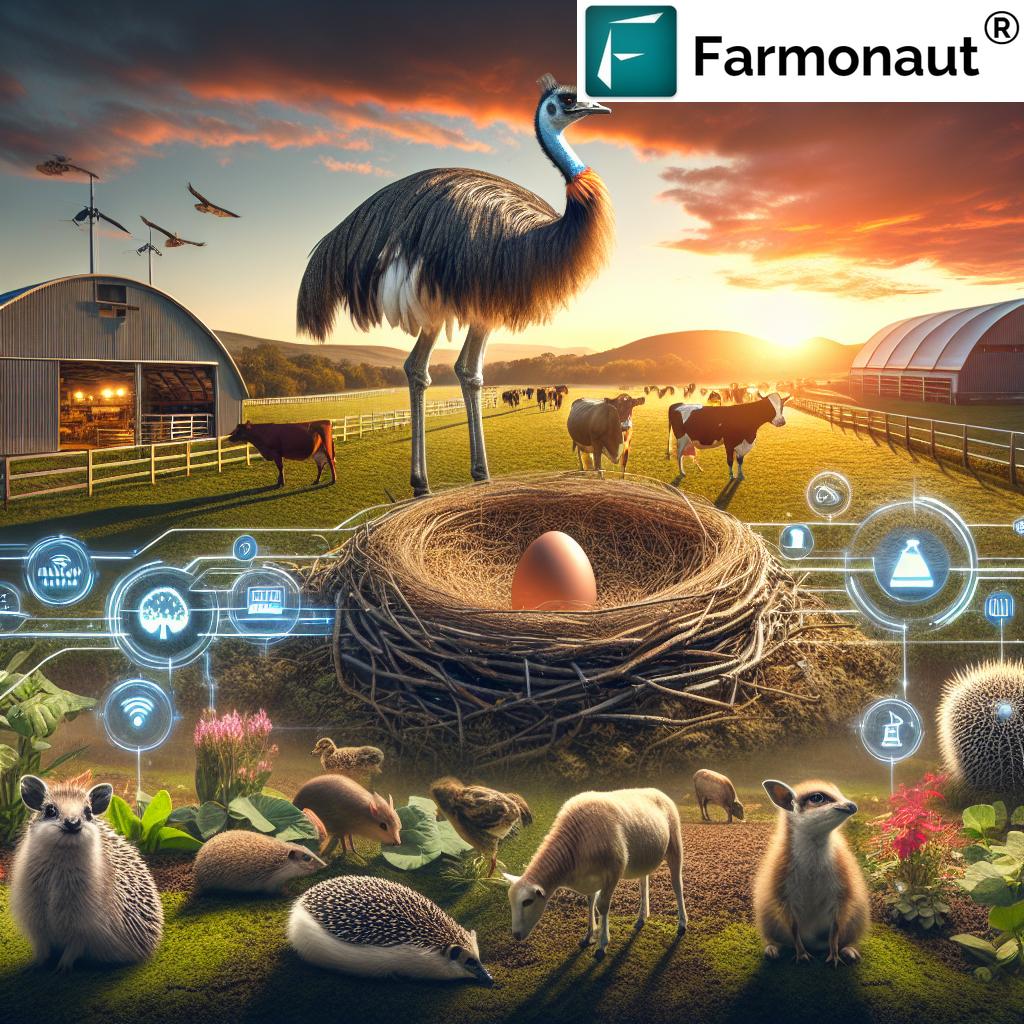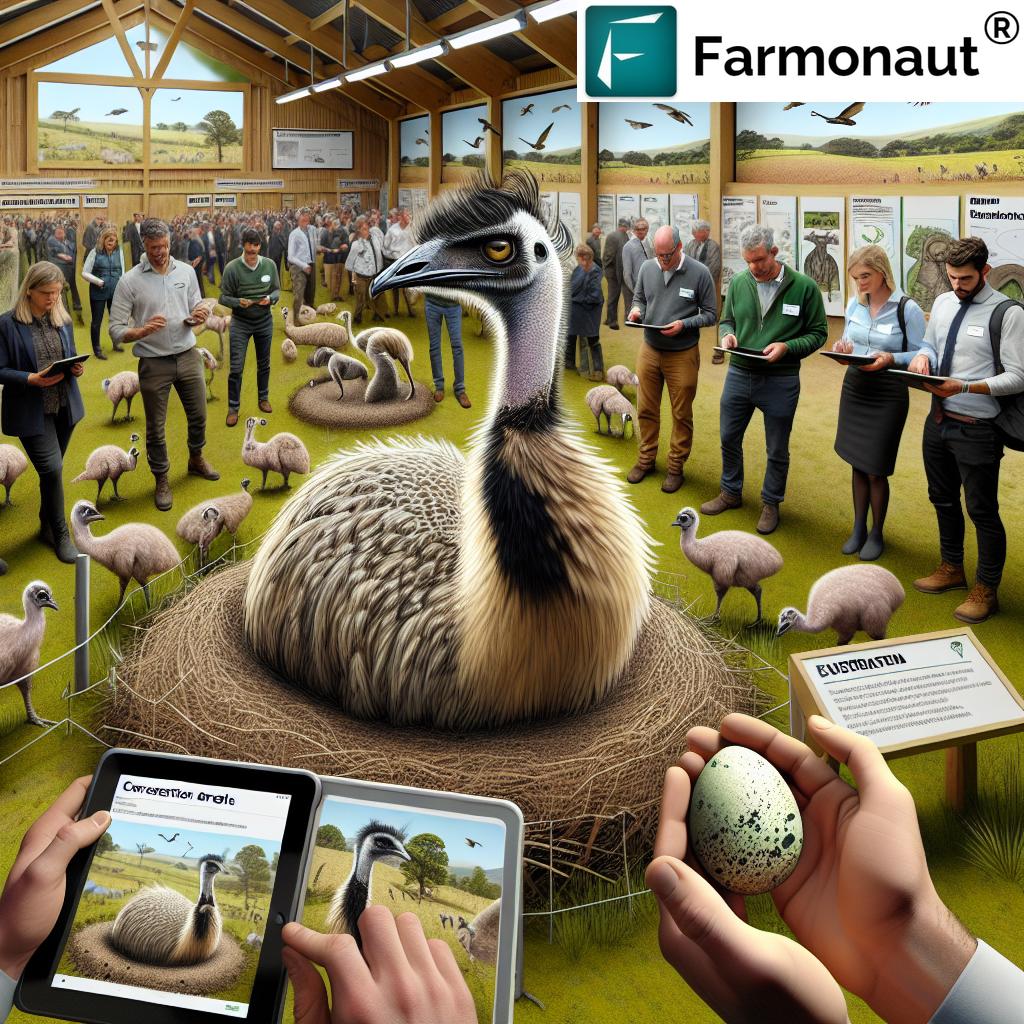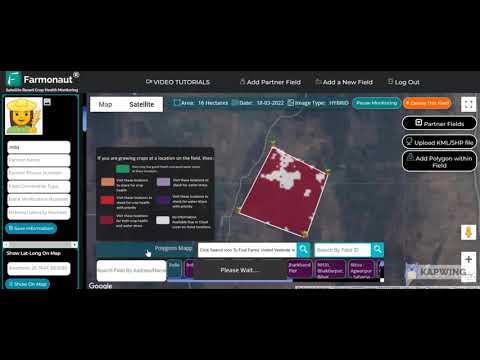Rare Rhea Lays Egg at Dorset Farm Park: Witness Threatened Flightless Bird’s Unique Parenting Behavior
In a thrilling moment for rare bird conservation, we recently witnessed an extraordinary event at a local farm park in Dorset, England. Bubba, a flightless rhea, laid an egg, showcasing the unique animal behaviors of this threatened wildlife species. This exciting occurrence not only offers visitors an exceptional agricultural education experience but also emphasizes the significance of sustainable farming practices in preserving biodiversity.
As we delve into this fascinating story, we’ll explore the world of rheas, their distinctive lifestyle, and the crucial role of farm parks in safeguarding rare species. Join us on this journey to discover how exotic bird breeding and wildlife observation techniques contribute to global conservation efforts.

“Male rheas, like Bubba, take on 100% of egg incubation duties, showcasing unique parenting behavior in the animal kingdom.”
The Remarkable Rhea: A Flightless Wonder
Rheas are among the most fascinating creatures in the animal kingdom. Native to South America, these flightless birds belong to a unique group of avian species that have adapted to a terrestrial lifestyle. Despite their inability to fly, rheas have developed remarkable features that make them well-suited to their environment.
- Rheas are the largest birds native to South America
- They can reach heights of up to 5.5 feet (1.7 meters)
- Their powerful legs allow them to run at speeds of up to 40 mph (64 km/h)
- Rheas have a distinctive three-toed foot structure, unlike their African cousins, the ostriches
As we explore the world of rheas, it’s crucial to understand their role in the ecosystem and the challenges they face in the wild. By studying these magnificent birds in controlled environments like farm parks, we gain valuable insights into their behavior and needs, which can inform conservation efforts in their natural habitats.
Bubba’s Big Moment: The Egg-Laying Event
The recent egg-laying event at the Dorset farm park was a momentous occasion for both the rhea conservation efforts and the local farming community. Bubba, the female rhea, demonstrated remarkable behavior leading up to and during the egg-laying process, providing a unique opportunity for visitors and researchers alike to observe these rare birds up close.
Prior to laying the egg, Bubba exhibited a defensive stance, a behavior typical of rheas in the wild when they feel threatened or are preparing for a significant event. This display of natural instincts highlights the importance of creating environments in farm parks that closely mimic the birds’ natural habitats, allowing them to express their innate behaviors.
The egg-laying process itself was captured on video for the first time, offering invaluable data for researchers studying rhea reproduction. This documentation will contribute to our understanding of rhea breeding patterns and help improve conservation strategies for these threatened birds.
Unique Parenting Structures: The Male Rhea’s Role
One of the most intriguing aspects of rhea behavior is their unusual parenting structure. Unlike many bird species where the female takes on the majority of incubation duties, male rheas are responsible for incubating the eggs and caring for the chicks once they hatch.
In the case of Bubba’s egg, we observed the male rhea taking charge of the incubation process immediately after the egg was laid. This behavior demonstrates the complex social structures within rhea groups and highlights the importance of both male and female roles in ensuring the survival of their offspring.
- Male rheas incubate eggs from multiple females
- They can care for up to 50 eggs in a single nest
- Incubation period lasts approximately 40 days
- Males are highly protective of their nests and will aggressively defend them from predators
By studying these unique animal parenting structures, we gain valuable insights into the diversity of reproductive strategies in the animal kingdom. This knowledge not only enhances our understanding of rheas but also contributes to broader conservation efforts for threatened species worldwide.
The Importance of Farm Parks in Conservation
Farm parks play a crucial role in the conservation of rare and threatened species like the rhea. These facilities provide a controlled environment where animals can thrive while also offering valuable opportunities for public education and research. The Dorset farm park where Bubba laid her egg is an excellent example of how these establishments contribute to wildlife protection and sustainable farming practices.
“Rheas are among the largest flightless birds, with only 2 species surviving today, both native to South America.”
Some of the key benefits of farm parks in conservation efforts include:
- Providing a safe habitat for threatened species
- Facilitating breeding programs for rare animals
- Offering educational experiences for visitors of all ages
- Supporting research on animal behavior and conservation techniques
- Promoting sustainable agriculture and wildlife coexistence
By visiting farm parks and supporting their conservation initiatives, we can all play a part in protecting threatened species like the rhea. These facilities serve as living laboratories, where we can observe and learn from rare animals while contributing to their preservation for future generations.

Wildlife Observation Techniques: A Closer Look
The successful documentation of Bubba’s egg-laying event highlights the importance of effective wildlife observation techniques. By employing modern technology and traditional methods, researchers and farm park staff can gather valuable data on animal behavior without disturbing the natural processes.
Some of the techniques used in observing rheas and other rare species include:
- Remote cameras and video monitoring systems
- Non-invasive tracking devices
- Behavioral observation logs
- Habitat enrichment studies
- Collaborative research with other conservation organizations
These observation methods not only provide insights into the lives of individual animals but also contribute to our broader understanding of species behavior, habitat requirements, and conservation needs. By refining these techniques, we can continue to improve our ability to protect and preserve threatened wildlife around the world.
Exotic Bird Breeding: Challenges and Triumphs
Exotic bird breeding programs, like the one that produced Bubba and her egg, are essential components of conservation efforts for threatened species. These programs face unique challenges but also offer significant opportunities for success in preserving rare bird populations.
Some of the key aspects of exotic bird breeding programs include:
- Genetic diversity management
- Specialized nutrition and healthcare
- Habitat replication
- Behavioral enrichment
- Reintroduction planning
The success of Bubba’s egg-laying at the Dorset farm park demonstrates the potential for these breeding programs to contribute significantly to the conservation of threatened species. By providing optimal conditions for rare birds to thrive and reproduce, we increase the chances of maintaining healthy populations both in captivity and, eventually, in the wild.
Agricultural Education: Learning from Rare Species
The presence of rare species like rheas in farm park settings offers unique agricultural education opportunities. Visitors of all ages can learn about the diversity of animal life, the importance of conservation, and the role of sustainable farming practices in preserving biodiversity.
Some of the educational benefits of observing rare species in farm parks include:
- Understanding the interconnectedness of ecosystems
- Learning about animal adaptations and behaviors
- Exploring the challenges faced by threatened species
- Discovering the role of agriculture in conservation
- Inspiring future generations of conservationists and farmers
By witnessing events like Bubba’s egg-laying, visitors gain a deeper appreciation for the complexity and beauty of the natural world. This firsthand experience can inspire a lifelong interest in conservation and sustainable living practices.
Sustainable Farming Practices: A Win-Win for Wildlife and Agriculture
The success of rare species breeding programs in farm park settings highlights the potential for harmonious coexistence between agriculture and wildlife conservation. By implementing sustainable farming practices, we can create environments that benefit both domestic livestock and threatened species.
Some sustainable farming practices that support wildlife conservation include:
- Habitat preservation and restoration
- Reduced use of harmful pesticides and chemicals
- Implementation of wildlife corridors
- Rotational grazing systems
- Agroforestry and mixed-use landscapes
These practices not only support the conservation of rare species like rheas but also contribute to the overall health of ecosystems and the long-term sustainability of agricultural operations. By adopting these methods, farmers and conservationists can work together to create a more balanced and resilient environment for all species.
The Global Impact of Local Conservation Efforts
While Bubba’s egg-laying event took place in a small farm park in Dorset, its significance extends far beyond the local community. The success of such breeding programs contributes to global conservation efforts and helps raise awareness about the importance of protecting threatened species worldwide.
Some of the ways local conservation efforts impact global wildlife protection include:
- Contributing to international breeding programs
- Sharing knowledge and best practices with other conservation organizations
- Inspiring similar initiatives in other regions
- Raising public awareness about threatened species
- Supporting research that informs global conservation strategies
By celebrating and supporting local conservation successes like Bubba’s egg-laying, we contribute to a larger movement dedicated to preserving the planet’s biodiversity for future generations.
The Role of Technology in Conservation
As we continue to face global challenges in wildlife conservation, technology plays an increasingly important role in our efforts to protect threatened species. Advanced tools and platforms, such as those offered by Farmonaut, can significantly enhance our ability to monitor and manage both agricultural lands and wildlife habitats.
Farmonaut’s satellite-based farm management solutions provide valuable insights that can benefit both farmers and conservationists. By leveraging these technologies, we can:
- Monitor crop health and land use patterns
- Identify potential wildlife habitats within agricultural areas
- Optimize resource management to reduce environmental impact
- Track changes in vegetation and land cover over time
- Support data-driven decision-making in conservation efforts
While Farmonaut’s primary focus is on agricultural applications, the data and insights provided by their platform can indirectly support conservation efforts by promoting more sustainable and efficient farming practices. This, in turn, can lead to better land management and reduced pressure on natural habitats.
Explore Farmonaut’s innovative solutions

Rhea Conservation Status and Behavior Comparison
| Species | Conservation Status | Native Habitat | Egg-Laying Behavior | Parenting Behavior |
|---|---|---|---|---|
| Rhea | Near Threatened | South American grasslands | Multiple females lay eggs in a single nest | Male incubates eggs and cares for chicks |
| Ostrich | Least Concern | African savannas and deserts | Dominant female lays eggs in a communal nest | Male and female share incubation duties |
| Emu | Least Concern | Australian grasslands and forests | Female lays eggs in a ground nest | Male incubates eggs and cares for chicks |
| Kiwi | Vulnerable to Critically Endangered (varies by species) | New Zealand forests | Female lays one of the largest eggs relative to body size | Male incubates the egg for 70-80 days |
Looking to the Future: Conservation Challenges and Opportunities
As we celebrate the success of Bubba’s egg-laying at the Dorset farm park, it’s important to recognize the ongoing challenges faced by rheas and other threatened species in the wild. Climate change, habitat loss, and human-wildlife conflict continue to pose significant threats to biodiversity worldwide.
However, events like these also highlight the potential for positive change. By supporting conservation initiatives, implementing sustainable practices, and leveraging technology to enhance our understanding of wildlife, we can work towards a future where rare species like rheas can thrive both in protected environments and in their natural habitats.
Some key areas of focus for future conservation efforts include:
- Expanding protected areas and wildlife corridors
- Enhancing international cooperation in conservation efforts
- Developing innovative technologies for wildlife monitoring and protection
- Promoting sustainable agriculture and land use practices
- Increasing public awareness and engagement in conservation issues
By addressing these challenges and embracing new opportunities, we can help ensure that future generations will have the chance to witness and learn from remarkable creatures like Bubba and her offspring.
Conclusion: A Hopeful Future for Rheas and Rare Species
The successful egg-laying event at the Dorset farm park represents a significant milestone in rhea conservation efforts. It demonstrates the potential for farm parks and other controlled environments to play a crucial role in preserving threatened species while also providing valuable educational experiences for visitors.
As we continue to face global challenges in wildlife conservation, it’s essential to celebrate and learn from successes like these. By combining traditional conservation methods with innovative technologies and sustainable practices, we can work towards a future where rare and threatened species like rheas can thrive alongside human communities.
Let us take inspiration from Bubba’s story and redouble our efforts to protect and preserve the incredible diversity of life on our planet. Through education, conservation, and sustainable practices, we can ensure that future generations will have the opportunity to witness the wonders of the natural world, including the remarkable rhea.
FAQ: Rheas and Conservation at Farm Parks
Q: Why are rheas considered threatened?
A: Rheas face threats from habitat loss, hunting, and climate change in their native South American habitats.
Q: How do farm parks contribute to rhea conservation?
A: Farm parks provide safe breeding environments, support research, and offer educational opportunities about rare species.
Q: What makes rhea parenting behavior unique?
A: Male rheas take on the primary role of incubating eggs and caring for chicks, which is unusual among bird species.
Q: How can visitors support rhea conservation at farm parks?
A: By visiting farm parks, learning about conservation efforts, and supporting their programs, visitors contribute to rhea protection.
Q: Are there plans to reintroduce captive-bred rheas to the wild?
A: While reintroduction is a long-term goal, current efforts focus on maintaining healthy captive populations and supporting wild habitat conservation.
Explore Farmonaut’s innovative agricultural solutions:





